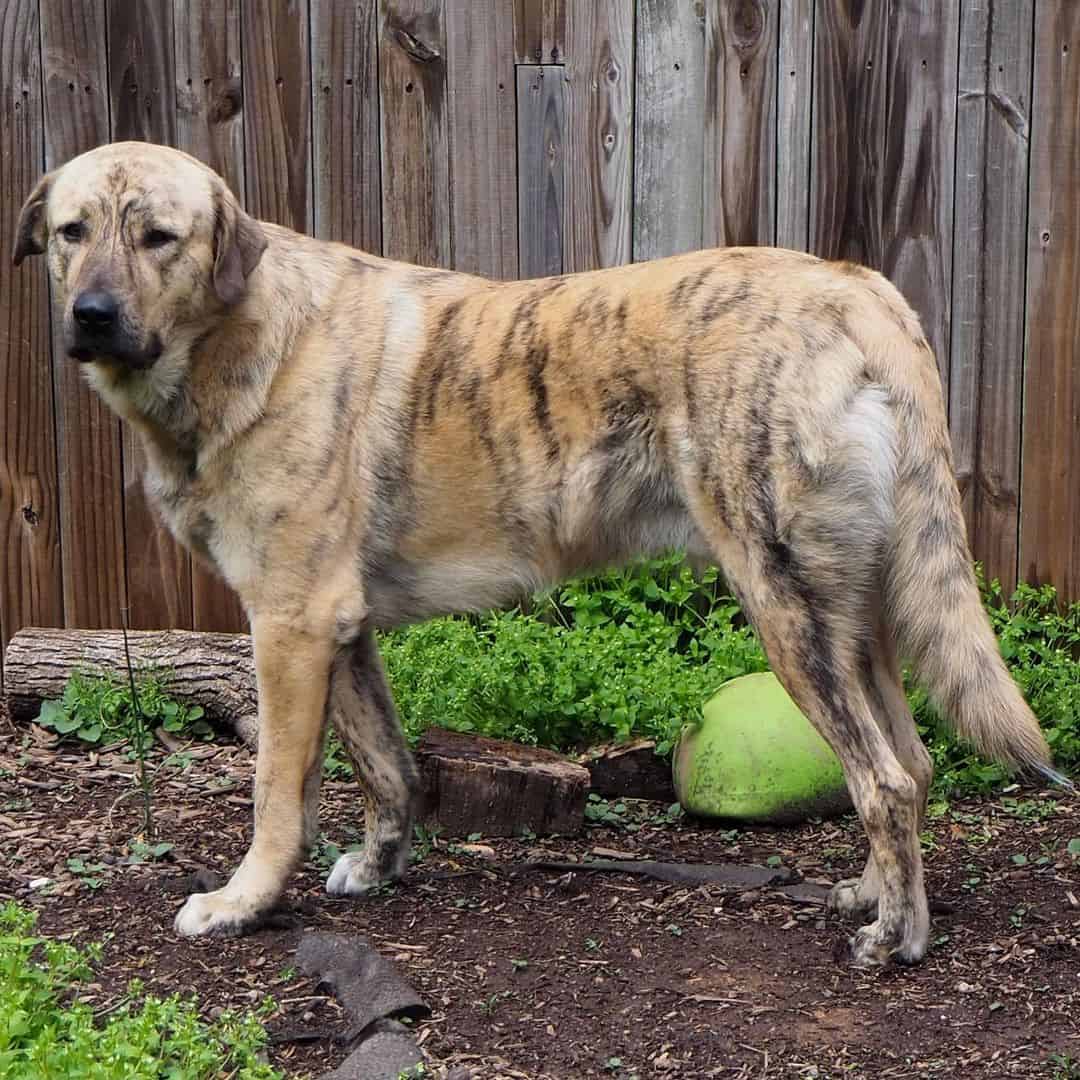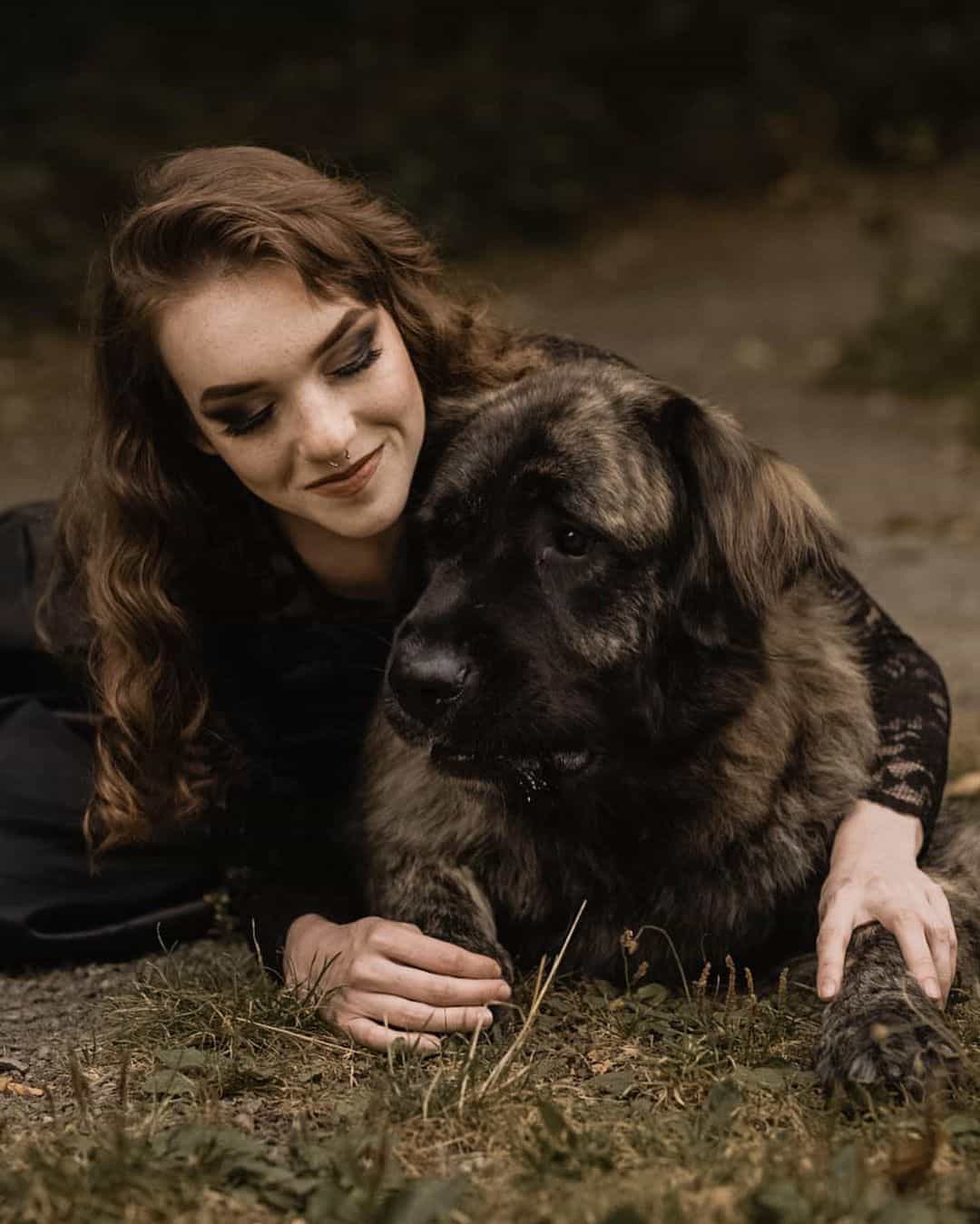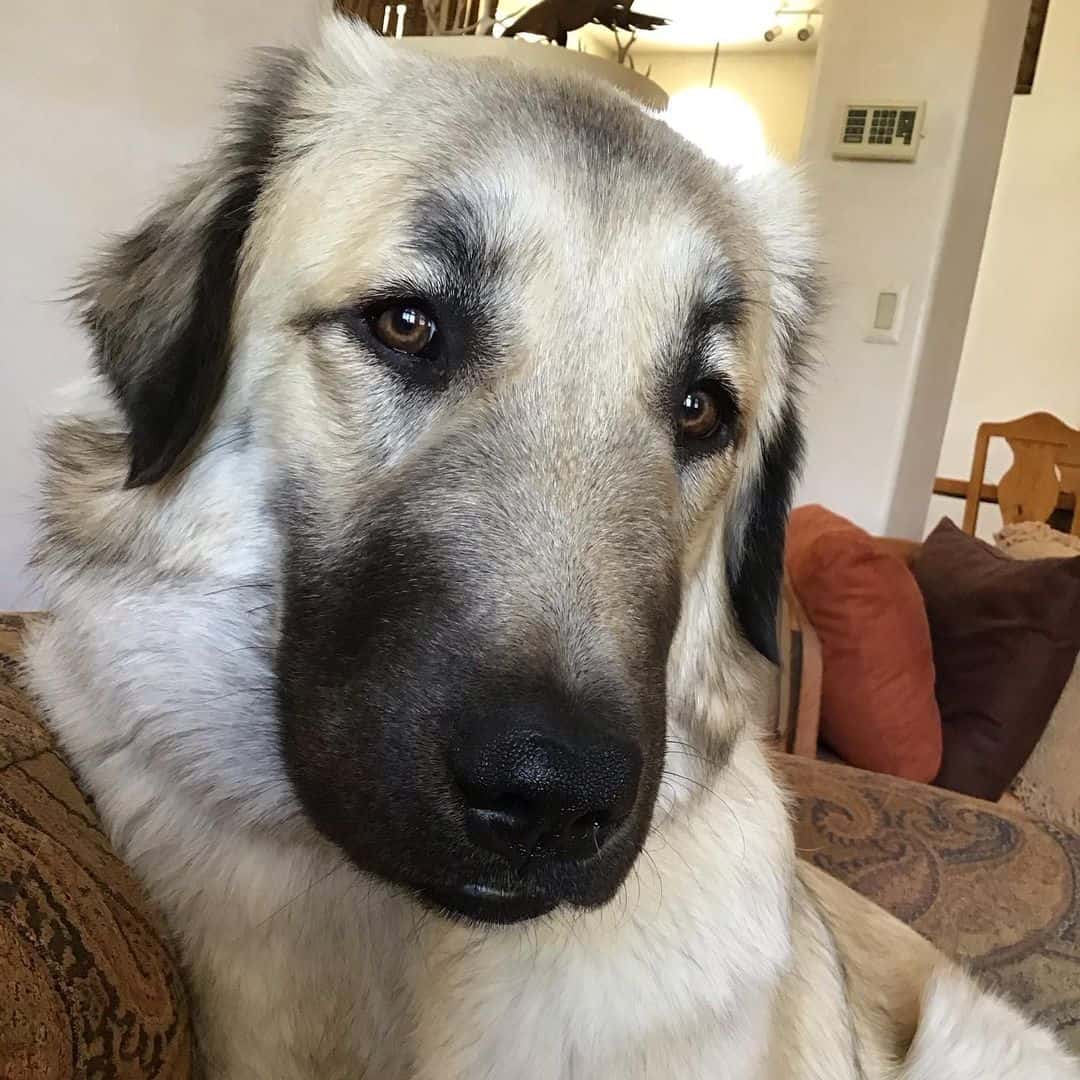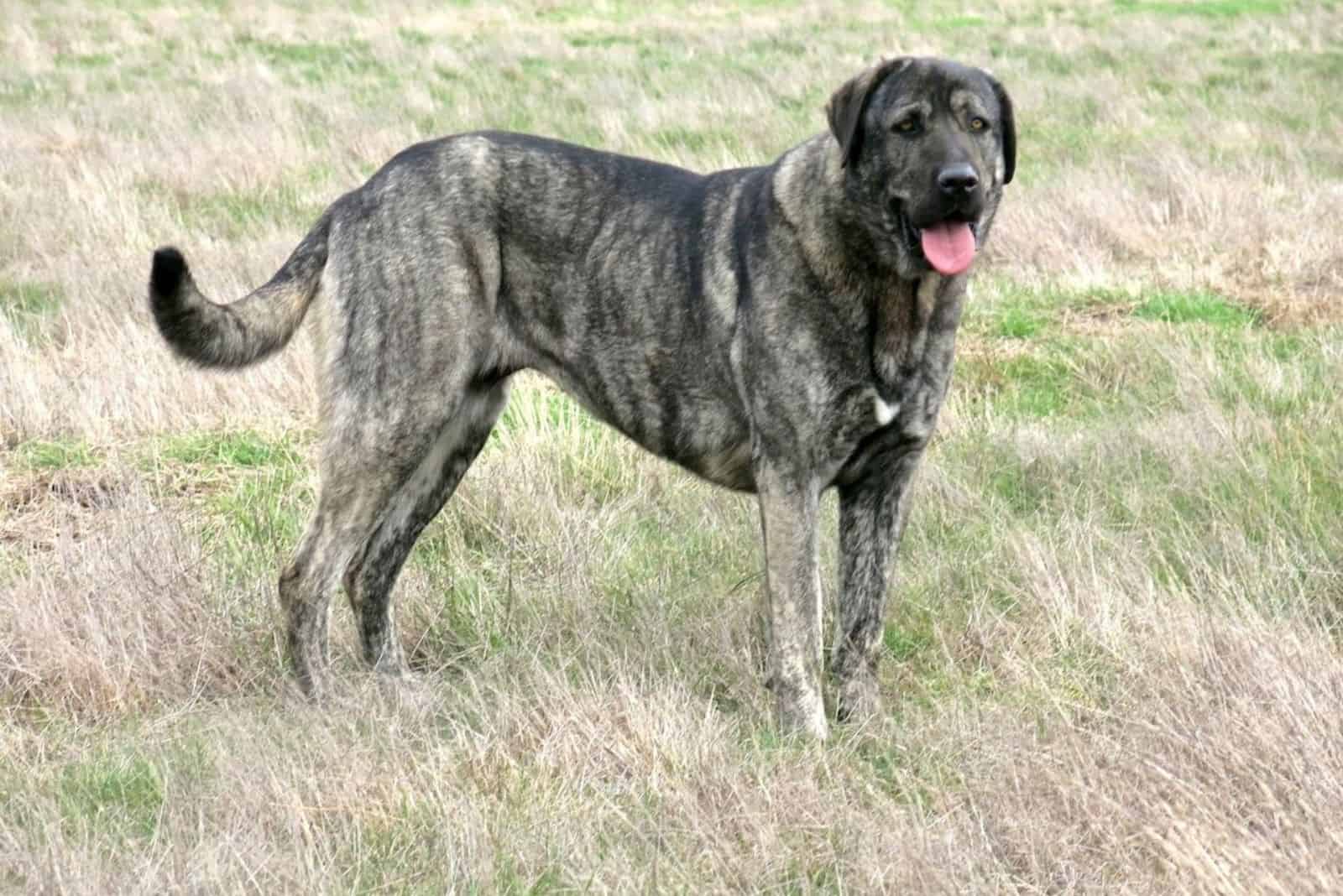The Anatolian Shepherd is among the more fashionable, rowdy dog breeds with a little more than half a dozen coat color options. Whether you prefer solid colors or patterns, there will be something for you with the mighty Turkish livestock guardian.
One of the most sought-after coats of the breed is the brindle Anatolian Shepherd. This pattern makes it feel closer to its ancestors, which is a useful trait to have when you are a herding dog.
Dog owners are fond of the brindle Anatolian Shepherd, too, due to the unique distribution of colors that end up having accented hair. Since there is more to dog coat colors than meets the eye, we will go through some canine genetics terminology to find out what happens backstage.
The Brindle Anatolian Shepherd Dog Genetic Breakdown

Fawn is the most common color in Anatolian Shepherds, so most owners will have dogs that display different shades of fawn at best. If owning this enormous Turkish herding and hunting dog is not eye-catching enough, then you will want a brindle-coated one.
There can be several color combinations for the brindle Anatolian shepherd. The base coat can be black, blue, gray, cream or fawn, while the stripes are most commonly black or fawn, depending on the genetics.
Cream base coats will express fawn striping in the majority of cases, while the other four base coat colors will have black striping. With breeders producing Anatolian Shepherd puppies with new color combinations, I am sure there will be even more variety.
Although genetic tests still cannot reveal exactly how a brindle coat comes to be, at least part of the process is known, so keep reading to find out what dominant and recessive genes on different loci do to give the dog a tiger-like stripe pattern.
Gene Dominance, Loci, And Proteins That Make The Brindle Anatolian Shepherd Coat
Everyone has heard about dominant and recessive genes, as we all carry one or both types. Alleles are gene variants found on loci (locations on a gene) that determine coat color in dogs according to which two alleles are paired on a locus.
Eumelanin and phaeomelanin are two pigments that are responsible for all color and pattern possibilities on a dog’s coat. However, different loci interact with each other, and the results of those interactions are sometimes less straightforward than we would think.
The MC1R gene controls both eumelanin (black) and phaeomelanin (red) production and, in interaction with the Agouti Signaling Protein (ASIP), which is an on-off switch for pigment production and distribution, can create some rather complex colors and patterns.
Applying This To The Brindle Anatolian Shepherd
Anatolian shepherds are usually fawn, which means that the E locus (extension) mostly carries the dominant E allele. The dominant gene will always overrule the recessive one, so E/E and E/e both give the signal to the MC1R gene that the red pigment should not be produced.
Next in the chain of command is the K locus. A brindle Anatolian shepherd dog must have two recessive genes (Kʸ/Kʸ, Kᵇʳ/Kᵇʳ or Kʸ/Kᵇʳ) on this gene location for a chance to get a brindle pattern on its coat.
Once the MC1R gene is finished with this checkpoint, it transfers its deciding power to the Agouti gene to figure out how to proceed next. The A locus and the pairing of alleles on it will determine whether the dog will be fawn, brindle (must have one Kᵇʳ allele), or brown-black.
If the dominant gene on the A locus (A) is part of the pairing, eumelanin production will be halted, and phaeomelanin will be used to color the coat. So an A/A or A/a pairing will open the way for the Kᵇʳ allele to result in a brindle pattern.
Because it is the second most dominant gene (after KB) on the K locus, only one puppy parent has to carry the gene for the dog to express a brindle coat, as long as the second parent does not carry a KB dominant gene.
The final coat color (light or dark brindle) of the Anatolian Shepherd puppy will be determined by the Agouti gene since it controls the distribution, amount, and switching between eumelanin and phaeomelanin.
An aʸ allele on the A locus will make the brindle pattern visible across the dog’s entire body, while the presence of two aᵗ alleles restricts it only to the stomach area.
Explaining The Genetics Of The Anatolian Shepherd’s Markings
The AKC accepts any markings on the Anatolian Shepherd, so the possibilities range from a simple brown or black mask all the way to pinto and dutch markings.
Melanistic masks (black or brown) on the muzzle occur when one or both parents of an Anatolian Shepherd puppy have the dominant Eᵐ allele on the Eᵐ locus. However, on dark-coated dogs, the mask might be the same color and not visible.
This is not the case with the Anatolian Shepherd, as fully black or brown coat colors are not a phenotype found in the breed.
When it comes to markings on other parts of the body, there is plenty of unknown, but until today, the S locus has been found to have a connection with white markings, white spotting, and predominant white coats.
Our interest lies in the white neck, chest, stomach, inner legs, and tail markings or spots, and the best place to start is the S locus. The dominant gene in this locus will not express any white spotting or markings on a dog’s coat.
Having one recessive gene (sᵖ) will express zero to fifty percent white coverage on the body. Similarly, a pair of sᵖ alleles will result in a phenotype that has between fifty and one hundred percent white coverage.
Anatolian Shepherd dogs that are white are not actually completely white but have a strong red dilute that becomes a near-white cream color. The markings that are related to the sᵖ allele are called pinto and dutch.
Pinto creates two small white circles just above the inner corner of the dog’s eyes. At the same time, dutch markings represent a symmetrical distribution of white from the neck, following the stomach, and extending onto the inner side of the legs.
Brindle Anatolian Shepherd Temperament

Coming from the Mastiff group of working dogs, the brindle or any other color Anatolian Shepherd is known for its strong purpose-driven lifestyle. They are extremely territorial and wary of strangers. These are individualistic dogs that will not shower you with love.
Feeding them and providing shelter is the deepest level of connection you can expect to develop with an Anatolian Shepherd dog. With that in mind, they will barely respond to obedience training.
They are moderate barkers with unrivaled protective instincts and will not join you in couch potato sessions. Ranchers used them as guards and herding dogs for a reason — they could cover vast areas of land and fight multiple wolves at once.
For this reason, keeping one in the apartment will not be a good experience. Even if you have a large yard, their territorial instincts will push them to break free and dominate every inch of space available. In Namibia, they helped save cheetahs from getting killed by chasing them off.
Because they are not the best family pets, early socialization is extremely important to accustom them to other dogs, young children, or guests. Mental stimulation needs are not moderate, but if left alone in the house, there is a high likelihood of finding chewed-up stuff once you are back.
Brindle Anatolian Shepherds Health Issues
Among the most common diseases encountered in this breed are hip dysplasia, elbow dysplasia, hypothyroidism, entropion, and bloat that develops into GDV.
Brindle Anatolian Shepherds are relatively healthy dogs, but dog owners should keep tabs on their dog’s calorie intake. Cheap commercial foods are filled with corn and grains, which can lead to weight gain and obesity.
Choosing high-quality commercial dog foods and preparing home-cooked or raw meals are only a few ways to provide a nutrient-rich, comprehensive diet without increasing the risk of weight gain. Of course, treats must be part of the daily calorie intake to avoid obesity.
Hip And Elbow Dysplasia
An underdeveloped femur bone ball that does not form a perfect fit with the hip socket creates an anatomically abnormal joint. This condition is hereditary, and during the formative years of an Anatolian Shepherd puppy, the cartilage that is placed between the two bones wears off.
When this happens, bone tissue becomes damaged, followed by the development of arthritis. The symptoms of dysplasia include difficulty moving, irregular gait, and pain while exercising.
A vet might prescribe NSAIDs for pain management, but eventually, surgery will be necessary. Ostectomy or full hip replacement is the most common treatment option for hip dysplasia, while elbow dysplasia is mostly treated by ostectomy.
Hypothyroidism
A thyroid gland that does not produce enough thyroxine and triiodothyronine can be caused by autoimmune thyroiditis or thyroid gland atrophy. The former is a form of lymphoma, while the latter is characterized as fat cells replacing thyroid tissue.
Autoimmune thyroiditis is the most frequent cause of hypothyroidism in dogs and displays symptoms such as lethargy, weight gain without changes in appetite, dead hair and bald patches of coat, etc.
Treatment is usually a replacement hormone therapy which has to be moderated by the vet every few weeks or months. Because there is no cure for the condition, your dog will have to take treatment for the rest of its life.
Entropion
A pooch that has an inward-growing eyelid can develop lesions, cataracts, or ulcers on the cornea. This condition can develop at any point in your Anatolian Shepherd’s life, but in many cases, it is congenital.
Dogs that produce too much tear fluid, squint a lot, or display bloodshot eyes could be affected by entropion. Check out our article explaining the possible causes of red eyes in dogs for more information.
Routine surgery is the only treatment, followed by secondary care in the form of administering vet-prescribed eye drops, antibiotic ointments, etc.
Bloat And GDV
Large dogs with deep-seated chests can be more prone to bloat. Feeding two or three smaller meals to your dog instead of one big portion will help prevent a bloated stomach.
Bloat happens and, on occasion, can develop into gastric dilatation and volvulus. This condition can quickly become fatal as it causes pockets of air or gas to get trapped in the stomach, causing its dilatation (expansion).
An expanded stomach can start twisting and turning at one point, which is called volvulus. This condition requires emergency intervention as the dilatated stomach can press on the diaphragm and blood vessels surrounding the heart, causing labored breathing or collapse.
The only treatment is surgery with a few days of hospitalization for the dog. Dietary modifications and lifestyle changes can further help restore a good quality of life in dogs.
Anatolian Shepherd FAQ

Other than the light or dark brindle striping, Anatolian Shepherd dogs can be fawn, liver, white, red fawn, blue fawn, gray fawn, and biscuit and white.
All of these colors are recognized as breed standard by the American Kennel Club, so whichever color or pattern you have will not stop you from participating in or winning a conformation event.
There are some non-standard coat color combos that are considered standard in Turkey and some other countries, but not all kennel clubs accept them as such. These include every shade of fawn with white, for example, red fawn with white or gray fawn with white.
Without too many serious health issues, the breed is very healthy. A complete diet complemented by regular physical activity and regular vet checks should see your dog live between eleven and fifteen years.
This is an estimate, and your mileage may vary. Choosing the right breeder can lower or increase your dog’s lifespan, so research extensively about their breeding program, practices, references, etc.
You can consider adopting an Anatolian Shepherd rescue from the National Anatolian Shepherd Rescue Network or some other rescue group.
Short answer, no. Though they look similar, they are separate breeds. The Anatolian hails from the same-named region in Turkey, while the Kangal is a native dog of the Turkish town and region called Sivas.
More confusion ensues once you start reading about how people refer to the Anatolian Shepherd. In the US, that is its name (coming from Anatolia), but in Turkey, they call it Coban Kopegi and Karabash dog (Karabas).
In terms of physical features, the Kangal dog is taller than the Anatolian Shepherd dog but still retains the thick bones, imposing body frame, and guard dog instinct. Its coat length is slightly shorter than in the Anatolian Shepherd, but both sport a thick undercoat.
Grooming needs are higher for the Anatolian Shepherd, so dead hair flying around during seasonal coat changes can be brutal for people with allergies. The Kangal’s short coat is easier to groom with a furminator.
Kangals have a more relaxed personality but are still relatively high-energy large dogs. Both dogs share the same original role — that of livestock guardian dogs for Turkish shepherds back in the day.
Modern-day Kangals and Anatolian Shepherds are used as guard dogs.
Turkish people take pride in being the home of the Kangal shepherd and consider any non-standard coat colors as a tell that it is not a purebred dog. All Kangals should be solid colored in shades that range from tan to gray.
While you will find an Anatolian Shepherd Dog Club of America, the same cannot be said for the Kangal. Neither the AKC nor FCI recognizes it as a separate breed, whereas the United Kennel Club (UKC) accepts it as a fully-fledged breed.
Summary
Brindle Anatolian Shepherds are not rare, but they do look unlike any other combination of the breed. The uniqueness of the coat does not necessarily mean a unique character, but going off of coat color is not the worst thing either.
We learned quite a few things about canine genetics, including a part of the “brindling” process and how markings on the Anatolian Shepherd dog are created, so even if you read this article to kill time, you gained some information while eating dinner.
In case you are not enamored by the Anatolian Shepherd’s personality, then the Kangal might be a better choice for you and your family. Stay fresh and brindle.
